Old Havana: A Local’s Guide to Habana Vieja
In many ways, Old Havana (Habana Vieja) is the stereotypical Cuba you’re thinking of – beautiful vintage cars, historic yet faded facades, and cobblestone streets. But a deep dive into Old Havana Cuba will change your perspective of Cuba and show you there’s a lot more here than might first meet the eye.
There is so much to see and do in Old Havana, that you could easily dedicate a few days of your time in Cuba just to exploring this area. Don’t make the mistake of forgetting the rest of Havana, but give this complex neighborhood the time it deserves. It’s a bucket list travel destination for a reason!
In our ultimate local guide to Old Havana / Habana Vieja, we’re sharing a complete guide to what to do in Old Havana, places to stay, where to eat, and what to avoid. José was born and raised in Havana and spent his whole life here until age 25 – we hope it helps you feel at home in Havana like we do.
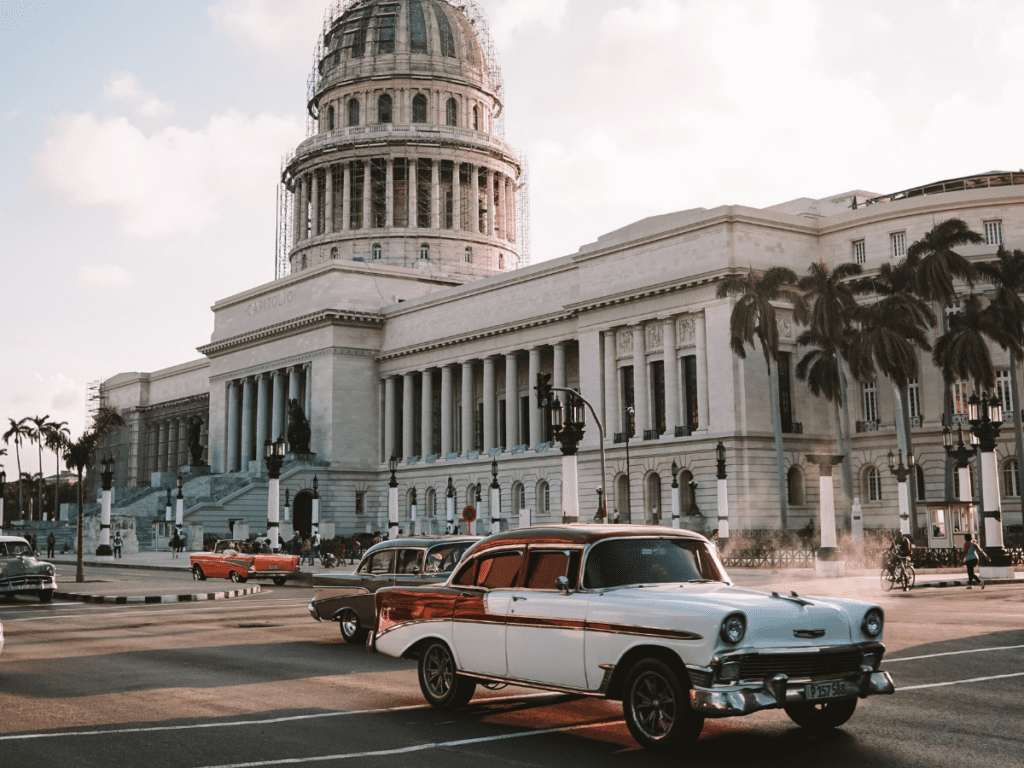
This post contains affiliate links that may reward me monetarily or otherwise when you use them to make qualifying purchases – at no cost to you. As an Amazon Associate, I earn from qualifying purchases. For more information, please read our disclosure policy.
Old Havana
The neighborhood of Habana Vieja – Old Havana – is the most famous neighborhood in the city, and a must-visit destination for any visitor to Cuba. Old Havana and its fortification systems are recognized as a UNESCO World Heritage Site, best known for its impressive and unique historical mix of architectural styles from its 500+ year history.
Here you’ll find the most historic architecture in the city, some dating back to the 1500s, and plenty of shops, art galleries, restaurants, and cafes to explore. Without a doubt, this neighborhood is lively, colorful, and vibrant, and you’ll likely want to spend a lot of your time in Havana exploring and taking in all it has to offer.
Havana is much more than just this one neighborhood – check out our Ultimate Travel Guide to Havana to see our recommendations for travelers throughout the WHOLE city. However, Old Havana is one of those special destinations that deserve time to explore. There is no place like it!
Habana Vieja
You’ll find that Old Havana (Habana Vieja) is very much a living, breathing neighborhood, which makes it so special. Here you’ll see kids in their uniforms running off to school, housewives sweeping dust out the front door, fruit and vegetable markets, and mechanics working on old cars – real life still happens here – it’s not just a monument to history.
Many visitors and commentators like to say that Cuba – especially Habana Vieja – is “trapped in the past” or “stuck in time” – we don’t say that here. Real people live, work, and thrive here, and saying they’re stuck in the past is offensive and untrue. Cuba has historic architecture and antique cars, but the people here are hard-working, dedicated, and very much looking to the future.
What is the Difference Between Havana and Old Havana?
Old Havana is merely one neighborhood in the city of Havana, which is quite an expansive city composed of over 15 municipalities. Old Havana is a relatively small neighborhood – you can walk from one end to the other in about 25 minutes – when compared to others in the city.
Many locals will refer to Old Havana (La Habana Vieja) as, simply, Havana. This can be a little confusing if you’re chatting with a local, but it is quite common.
While Old Havana is, of course, home to the oldest section of the city, you’ll still find beautiful, relatively old architecture in other areas of the city. The Vedado and Playa neighborhoods, for example, are home to some of the city’s old, stately mansions. In other Havana neighborhoods, you’ll find relatively newer architecture mixed with older buildings.
Old Havana Map
I’ve created an Old Havana map to go along with this article – it has every location we recommend here, from the best restaurants in Old Havana to where to stay in Old Havana and much more. You’ll find we have dozens of recommendations for things to do in Havana, and we’ve tried to include almost every site of interest in Havana’s most famous neighborhood.
Click around and explore this map and come back as a reference. You can also download this Old Havana map for use in Cuba while you’re there!
Read More: 25+ Best Restaurants in Havana
Getting Around Old Havana
You’ll have no trouble getting around in Old Havana. This neighborhood is relatively small, and you can walk from one end to the other in probably around 20-25 minutes. You won’t need to catch a car or taxi to get around in Old Havana, though you might need one to get to other parts of the city.
Streets are narrow and generally don’t have that many cars, so you can easily meander through the street and take in the neighborhood as you explore Old Havana. If you’re looking for a taxi to take you to another part of the city, it’s best to walk to Parque Central, near the entrance to the Gran Hotel Manzana Kempinski, where you’ll find private taxis waiting. You can choose between a standard yellow taxi, or a vintage American car.
If you’re just headed across town, you’ll probably just want a yellow taxi; vintage cars are generally for tours of the city and are more expensive. Buses and shared taxis (máquinas) are accessible along the street that passes in front of the Capitolio building. Many buses and taxis also leave from the park on the south side of the Capitolio building, called Parque de la Fraternidad.
If you’re looking for a specific bus route or shared taxi route, make sure to check with your casa particular host or in your hotel, and don’t be shy about asking for help from passersby on the street.
What to Pack for Cuba
Check out our Ultimate Cuba Packing List to help you pack for your trip – we’re sharing exactly what to bring to Cuba and what we never travel without.
Things To Do in Old Havana, Cuba
We’ve put together a complete guide to all the best things to do in Old Havana, including every site you could possibly imagine and more. There is so much to see and do here that you couldn’t get to it all in a week. If you’re on a short Cuba itinerary, check out these Old Havana highlights.
Old Havana Highlights – Best Things To Do in Old Havana
Just a few short hours to spend in Havana? These are the sites you MUST visit – the best of the best of the city, to see the most in the least amount of time. Some won’t take more than a few minutes to see – Parque Central, Capitolio, and the Gran Teatro de la Habana are clustered together! – but they’re worth the visit.
- Havana’s Four Central Plazas
- Castillo de la Real Fuerza
- Capitolio
- Calle Obispo
- Paseo del Prado
- Parque Central
- Gran Teatro de La Habana
- Clandestina
Havana’s Four Central Plazas
*Old Havana Highlight
Visiting Havana’s famed four central plazas is one of the best ways to see the city. Download Maps.Me on your phone before the trip and trace the route between these four parks – you’ve got yourself one of the best self-guided walking tours of Havana.
These four plazas (some add in Parque del Cristo as the fifth central plaza, though it isn’t nearly as impressive as the others) are home to some of the city’s most beautiful and best-restored architecture.
Plaza Vieja
Arguably the most picturesque of Havana’s four central plazas, this gorgeous plaza has colorful and lovingly restored historic buildings with stained glass arches and delicate balconies. It is ringed by restaurants, galleries, and even a small museum about the area’s history.
If you’re looking for a pick-me-up during a long day of exploring Old Havana, check out Cafe Bohemia – it’s one of my favorite cafes in Havana.
Plaza de Armas
Located just across from the start of the Malecón in the Havana Harbor, Plaza de Armas is Havana’s oldest plaza. This plaza is home to a large statue of Carlos Manuel de Céspedes, known as the father of the nation of Cuba.
The Plaza is inviting, mostly shaded by trees and with plenty of benches – its the perfect place to rest and take in the beauty of the square on a hot, sunny day.
Make sure to check out the Palacio de los Capitanes Generales on the west side of the square, home to the Museo de la Ciudad. The building is a lovely example of colonial architecture, and you’ll find peacocks living in the beautiful central courtyard.
Plaza de la Catedral
The Plaza de la Catedral is home to Havana’s… you guessed it… cathedral! This distinctive cathedral is considered one of the most beautiful examples of baroque architecture in the Americas, and is part of the UNESCO World Heritage designation in Old Havana.
It’s well worth a visit inside, and the church is usually open throughout the day. In addition to a lovely if somber interior, there are many famous Habaneros buried within the cathedral. The most famous was Christoper Columbus – he was buried here until 1898, when Cuba gained its independence from Spain and his remains were moved to Seville.
In addition to the cathedral, you’ll also find in this plaza the Museo de Arte Colonial, as well as art galleries. Take some time to pop into the buildings around the cathedral!
Read More: 50+ Facts About Cuba You Won’t Believe
Plaza de San Francisco de Asís
One of the oldest plazas in the city, the Plaza de San Francisco de Asís is surrounded by historic buildings and important buildings (Museo del Ron – Rum Museum, a religious art museum, etc.), including the Convento de San Francisco de Asís, built in the late 1500’s.
Make sure to climb the bell tower of the church for spectacular views over the whole city!
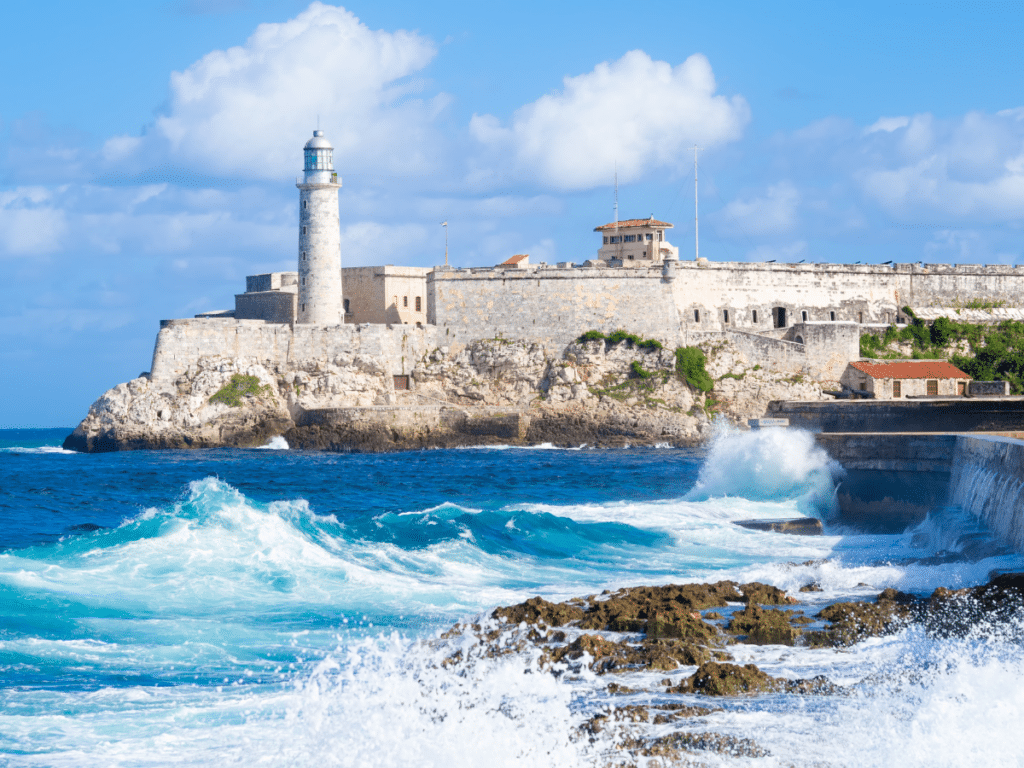
Castillo de la Real Fuerza
*Old Havana Highlight
Standing guard over the entrance to the Plaza de Armas is the Castillo de la Real Fuerza, one of Havana’s many fortresses protecting this important harbor. This fortress is the oldest in the Americas, completed in 1577 by the Spanish.
It is surrounded by a moat, massive, and a great place to visit to learn about the colonial history of the city.
Calle Obispo
*Old Havana Highlight
Calle Obispo is a pedestrian street that cuts through the heart of Old Havana. Lined with galleries, shops, small museums and important historical buildings, walking down Calle Obispo is a must when visiting the city. Start in Parque Central and head all the way to Plaza de Armas, or vice versa.
While there is no lack of things to see and do along the way, make sure to stop in all the independent art galleries along the street. José’s friends own and work from Galeria 360 (at Calle Obispo #360) – their hyperrealistic work is truly unbelievable. Make sure to stop by and tell them we sent you – maybe you’ll see us hanging around!
El Capitolio
*Old Havana Highlight
An important symbol of the city of Havana, el Capitolio – the capital building – bears a marked resemblance to the U.S. Capital building. Ongoing repairs and restoration left it closed for years, but it is now open to visitors.
The most impressive part of the building is the front steps and entrance atrium, in my opinion, so you don’t need to plan to visit the inside unless you are truly interested! From in front of the building, you can catch the morning HabanaBusTour T3 bus, which goes to Playas del Este – they’re not the best beaches in Cuba, though they’re great beaches close to Havana.
Havana Beaches Guides
Parque Central
*Old Havana Highlight
A central gathering place in the city, Parque Central – Central Park – is a great place to start a tour of the city. Around the park you’ll find several hotels, the Gran Teatro de la Habana, the entrance to Calle Obispo, and plenty of vintage American cars offering rides around the city. It’s a quick visit, but a great place to get a sense of Old Havana.
In the middle of the park, you’ll find the esquina caliente, or, “hot corner” where a group of guys gathers daily to argue about baseball. Sometimes baseball stars show up – we saw some MLB players visiting once! For an amusing addition to your Havana itinerary, we consider this one of the best things to do in Havana!
Gran Teatro de La Habana
*Old Havana Highlight
Facing the Parque Central and next to the Capitolio building, el Gran Teatro de La Havana is one of the most ornate buildings in Havana. Named after world-famous Cuban ballerina Alicia Alonso, this building is home to the Cuban National Ballet and has hosted performances from some of the world’s best ballet companies.
The interiors are spectacular, and performances are quite affordable, so attend a performance if you can! On the bottom floor of the building, you’ll find the Galeria Origenes art gallery, also worth a visit if you have the time.
Paseo del Prado
*Old Havana Highlight
A wide, tree-lined boulevard tracing a path from the Castillo de San Salvador de la Punta on the Malecón to the Parque Central, walking the Paseo del Prado is a must while in Havana. The walkway is lined with ornate lamps and made of beautiful stone and calls back to Cuba before the Revolution.
Here you’ll find kids riding skateboards, families and friends chatting or eating on benches, artists selling their wares, and much more.
Clandestina
*Old Havana Highlight
Clandestina isn’t your typical Old Havana spot, but it is certainly a must-visit. On the cutting edge of Cuba’s recent crop of independent businesses, Clandestina is Cuba’s first independent clothing brand. Their Old Havana store at the corner of Parque Cristo is an experience more than a store.
You can pick up their beautiful streetwear designs, accessories, poster, and home goods all with tongue-in-cheek designs about Cuba’s culture and people. Come here to get inspired about Cuba’s present and future, not just the past.
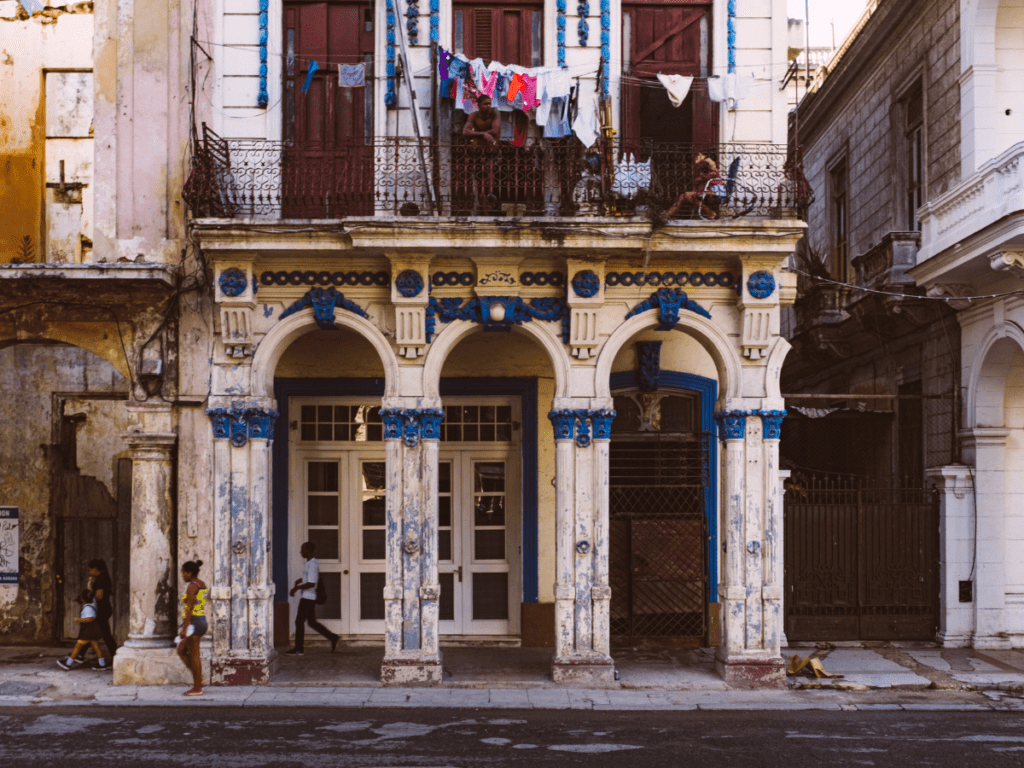
Attractions in Old Havana
Castillo de San Salvador de la Punta
Located at the entrance to the Havana Harbor, the Castillo de San Salvador de la Punta is often skipped by visitors in favor of a visit to the Castillo de la Real Fuerza – but this is a mistake!
Here you’ll find scale models of some of the initial Spanish ships to visit the island, relics from sunken Spanish ships, and much more. It’s very cool, you’ll love it. It is located directly across the harbor from El Morro – not in Old Havana but a must-visit destination in Havana for its incredible views of the city.
Palacio de los Capitanes Generales
Located on the east side of the Plaza de Armas, the Palacio de los Capitanes Generales is the former home to the governor of Havana, and is the home today to the Museo de la Ciudad (Museum of the City).
This beautiful colonial building is mostly kept in its original state, with original furniture and decorations, as well as exhibit halls about the city’s history.
Even if you’re not planning on visiting, just stepping through the courtyard from the plaza is enough to take in the splendor of the building, a lovely example of colonial architecture. original furniture. history of the city, home to the Museo de la Ciudad.
The courtyard is home to the Giraldilla sculpture, the famous local figure that appears on the Havana Club rum bottles.
Museo de la Revolución
The former presidential palace of Cuba before the Cuban Revolution, this ornate building is now the “Museum of the Revolution.” The taking of the residence was an important moment in the Cuban Revolution – the bullet holes on the building remain in memory of the event.
I love the Museo de la Revolución and recommend visiting, but unfortunately, there isn’t much information about the items on display in English, so if you don’t speak Spanish, it can be challenging to visit.
In the back of the museum, between the back of the building and the Museo de Bellas Artes, you’ll find a pavilion covering several boats, tanks, and cars – this is part of your admission to the Museo de la Revolución.
You’ll find a replica of the Granma (the ship Fidel used to return to Cuba from Mexico) as well as captured American cars and planes from the Bay of Pigs, and the car Fidel Castro used to enter Havana during the Cuban Revolution.
Read More: 10 Cities in Cuba Travelers Love

Museo Nacional de Bellas Artes
There are actually two fine arts museums in Havana, both known as the “Museo de Bellas Artes” – one is located between El Floridita bar and Parque Central, at the start of Calle Obispo. This is the Museo de Bellas Artes which focuses on art from around the world.
Housed in a beautiful, historic building with grand staircases and stained glass ceilings, the building alone is worth a visit. In this museum, you’ll find an impressive display of mostly European and American paintings, though the African and Asian galleries are fascinating as well.
They have frequent events and rotating exhibits, so check their schedule before you plan your visit.
Museo Nacional de Bellas Artes – Arte Cubano
The second fine arts museum in Havana, the Museo Nacional de Bellas Artes de Arte Cubano focuses on works by Cuban artists. If you’re going to visit just one, I would definitely recommend you choose this one, though both are fantastic!
While you’ll find works from centuries past, the most fascinating areas of the museum are those dedicated to post-Revolution art. You’ll find tons of political symbolism, which will shed light on a lot of what you’ll see as you tour the rest of Cuba.
Make sure you see the famous painting The Jungle by Cuban master Wifredo Lam – it looks quite similar to Picasso’s Guernica and is an impressive masterpiece even those who don’t know much about Cuban art will love.
Parque El Cristo
Home to the Iglesia del Santo Cristo del Buen Viaje church, this central park in Havana is an important meeting place. It’s one of Old Havana’s central plazas, though not as frequented by tourists, so here you’ll see more of day-to-day life in the neighborhood.
The church in the square is lovely, so make sure to pop in while you’re here.
There is a lot to do just around the park – the Clandestina store is just down Calle Villegas, a few steps from the park, El Dandy – a favorite restaurant – is on the corner, and El Café, my favorite cafe in Havana, is just down Calle Amargura.
Read More: 25+ Best Restaurants in Havana
Iglesia y Convento de la Merced
Hidden in a residential area of Old Havana, though relatively close to the Almacenes San José market, Iglesia y Convento de la Merced is one of my favorite churches in old Havana. Dating back to the mid 1600’s, this church has a beautiful and ornate interior.
Make sure to check it out if you have time – it’s rather off the beaten path, but quite beautiful!
Iglesia de San Francisco de Paula
This church, located right along the waters of Havana Harbor, has a beautiful and impressive interior, recently restored to its original glory, and worth a visit if it’s open when you’re here. The church also hosts concerts and modern art exhibits, so check the schedule when you’re here and make sure to visit.
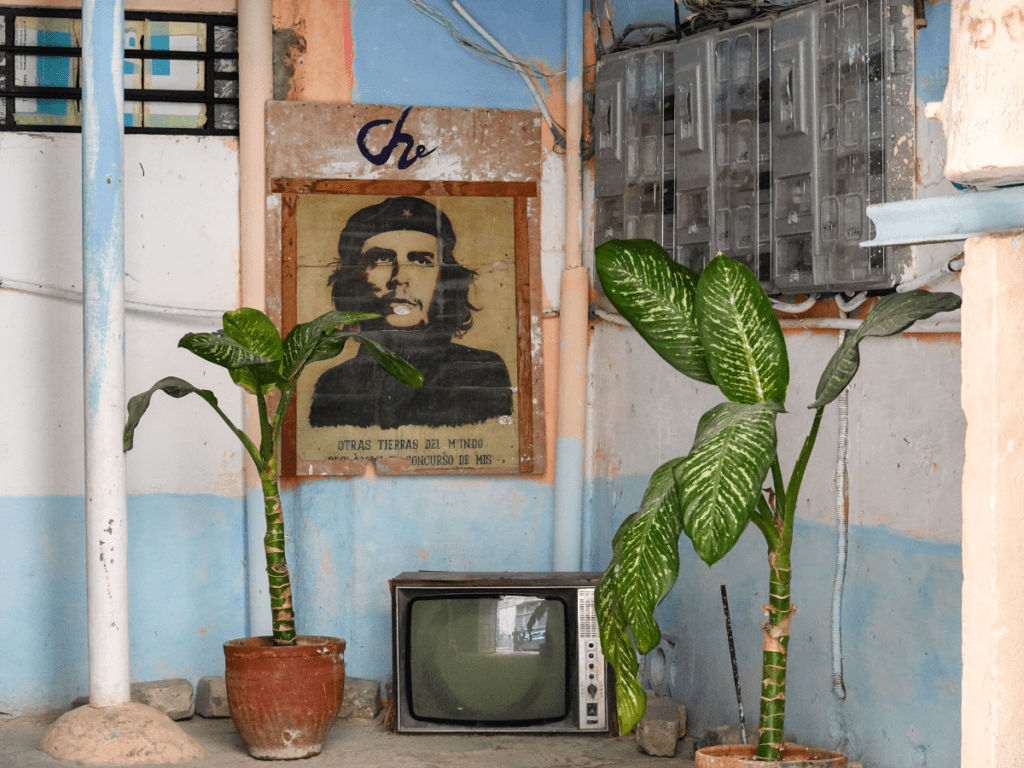
Iglesia del Santo Angel Custodio
Just around the corner from the Museo de la Revolución, this lovely church is set in a beautiful and historic square that oozes Old Havana charm. Several Cuban television series and movies have been filmed in this little square in front of the church for its beauty.
Check out the inside of the church, then enjoy a coffee at the cafe in the square and visit the neighboring art gallery. It’s a great place to take in the beauty of this historic neighborhood.
Museo del Ron Havana Club
The Havana Club Rum Museum is the kind of “museum” that even typical museum-goers will enjoy. The museum focuses on Havana Club rum – this is by far the most famous brand of Cuban rum, and the best.
You’ll learn about how rum is made, but won’t be bored to death by the details. It’s really quite an engaging visit. Go for the tour and you’ll get several taste tests included. It’s a fun way to learn about one of Cuba’s most popular exports.
Museo del Automovil
Holding a small but impressive collection of cars, the Museo del Automovil – Havana’s Car Museum – is a must-visit for antique car lovers. If you don’t have a particular interest in cars, just seeing the beautiful vintage cars that fill Havana’s streets is likely more than enough for you.
Travel Insurance
Cuba requires that all travelers have proof of a comprehensive travel insurance policy in order to enter the country. Check out our guide to travel insurance for Cuba for more details. We recommend these brands for Cuba travel insurance:
- Visitors Coverage: Coverage for Cuba travel available to citizens of all countries, though not currently available to residents of New York and Maryland in the United States.
- Insubuy: Coverage for Cuba travel available to citizens of all countries and states of the United States.
Museo Farmacia Taquechel
Located on Calle Obispo near the harbor, the Museo Farmacia Taquechel is a beautiful, historic pharmacy that instantly transports you back to Old Havana centuries ago. Opened in 1898, this pharmacy is restored to its original glory, with intricate woodworking on the walls displaying beautiful antique drug containers, scales, and much more.
Plus, the Museo Farmacia Taquechel still functions as a pharmacy today! Free to visit, it only takes a few minutes to pop in and appreciate this gorgeous restoration, emblematic of Old Havana.
Museo de la Farmacia Habanera
Similar to the Museo Farmacia Taquechel, the Museo de la Farmacia Habanera is another antique pharmacy in Havana. You’ll find similarly beautiful woodworking and historic details keeping this pharmacy in its original condition.
You’ll also find a few exhibit spaces with information about pharmacies and healthcare in Cuba’s past. While that may be of only a niche interest, this lovely pharmacy is still worth popping into and appreciating for its historic beauty.
Casa Oswaldo Guayasamin
The former home and studio to Oswaldo Guayasamin, Ecuador’s most famous artist and a great friend to Cuba, this lovely historic building in the heart of Old Havana is well worth a visit if you’re an art lover.
In the courtyard of the building and the surrounding rooms you’ll find rotating exhibits by artists from Cuba and around the world, and upstairs you’ll find Guayasamin’s former living quarters and some of his works.
The foundation here also offers art classes in Havana for children – José was a student here as a child and had his work on display for an exhibit that Guayasamin attended!
Parque La Maestranza
Located along the entrance to the Havana Harbor, there isn’t much to see or do for most visitors here. An area of the park is set aside as a playground with inflatables and small amusement park ride for kids.
However, for most visitors, this is an important spot because this is a great place to find a driver to take you on a tour of the city in a vintage American car.
This is a great place for a last-minute ride, but I highly recommend booking in advance if you can! Sometimes drivers can get a bit pushy, or jack up prices, so by booking ahead (click here!) you’ll avoid this – it can be uncomfortable.
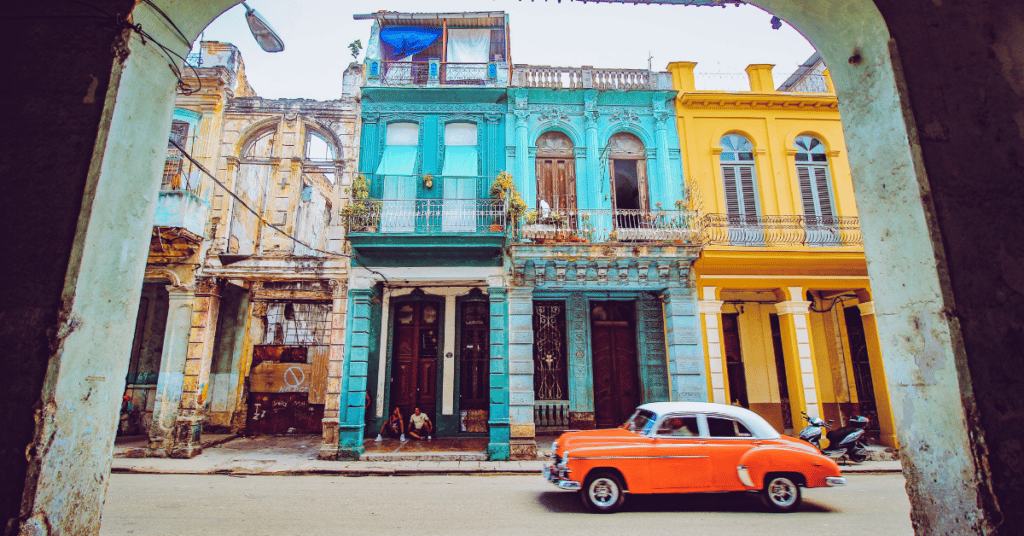
El Floridita
The most famous bar in Cuba – and many say, among the most famous bars in the world! – El Floridita opened in 1817 and remains a Havana institution.
Made famous as being a favorite watering hole for Ernest Hemingway and other literary figures who visited Cuba, there is a bronze statue of Hemingway at the bar, drinking his favorite daiquiri, a drink this bar made famous.
Today El Floridita is quite touristy – I wouldn’t eat here, though a drink at the bar on a hot day wouldn’t hurt. Even if you try to avoid tourist spots, sneak inside and walk through – this place is a part of history.
La Bodeguita del Medio
La Bodeguita del Medio bar around the corner from the Plaza de Armas claims to have invented the mojito, though these claims are disputed, as such origin stories generally are. Opened in 1942, this bar has been a favorite with visiting and homegrown writers, artists, and intellectuals.
Today it’s a bit overpriced, but worth a visit, even if only to take in the atmosphere and see the live music and street performers often outside.
Almacenes San José
Also known as Havana’s Artisan Market, this is the place to go if you’re looking to take home a piece of Cuba. This former shipping warehouse located along the port has been repurposed into a covered market where you’ll find clothes, jewelry, leather and wood products… pretty much everything you can imagine.
Most interesting is the art – you’ll find tons of styles, from often replicated and stereotypical portraits of El Che, to really unique artwork by Cuban artists.
Though industrial fans circulate air inside, it can get quite stuffy, so take a shopping break at the brewery (Cerveceria Antiguo Almacen de la Madera y El Tabaco) next door, inside another repurposed shipping warehouse.
Travel Essential
Don’t think about traveling to Cuba without a good VPN (Virtual Private Network). Using a VPN while connecting to the internet is an easy way to keep your personal information safe from hackers and trackers. We’ve used NordVPN for years and couldn’t recommend it more – it’s a must for safety online, especially in Cuba.
Dador
Dador is another new Cuban clothing brand with a lovely store in Old Havana. Just like in the Clandestina store, you’ll see artisans hard at work creating their products here.
Beyond Roots
Beyond Roots is both a store and a tour company dedicated to celebrating and teaching visitors about Afro-Cuban culture. They offer a variety of tours and classes, like walking tours of the important Afro-Cuban destinations in Havana, cooking classes, and more – choosing one is a true MUST if you’re interested in Afro-Cuban or Afro-Caribbean culture and history.
Memorias Librería
One of my favorite spots in Havana, Memorias Librería is a fascinating old antique shop located just off of Paseo del Prado. Visiting this fascinating shop is like stepping back in time.
You’ll find stacks and piles of old books, cigar boxes, pins, posters, and everything you could ever imagine. They specialized in old books, posters, photos, and other printed materials. This is better than any history museum in the city, in my opinion!
The shop is cramped but air-conditioned, a great escape from the middle of a hot day in Cuba.
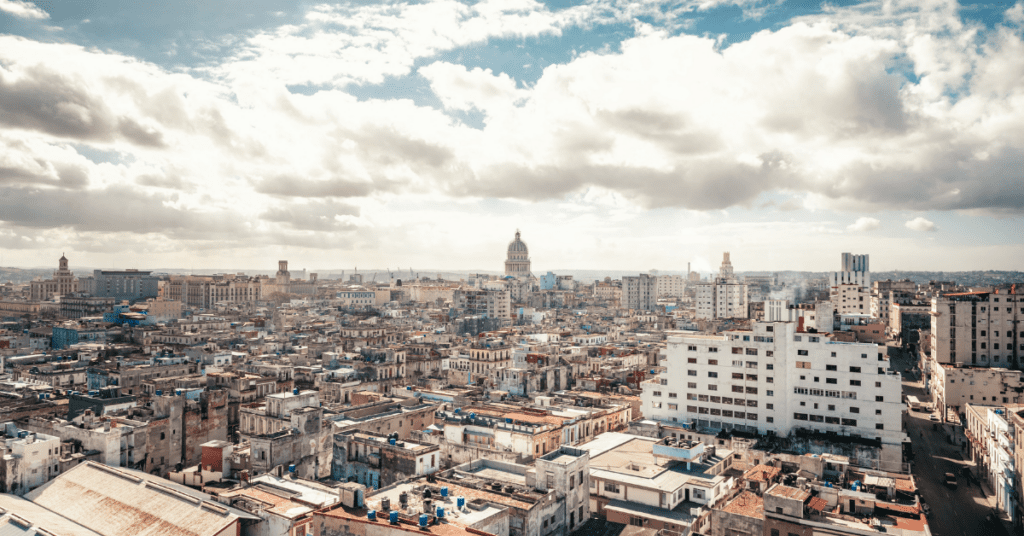
Where To Stay in Old Havana
Casa Giraldilla ($)
This charming and historic guesthouse is a perfect option if you’re looking for that Old Havana history. Casa Giraldilla is a great, affordable casa particular in Old Havana, with soaring ceilings, antique furniture, and fantastic hosts to match.
La Terraza de Prado ($)
You can not go wrong with this location – looking out over El Paseo del Prado, you’re just steps away from the best of Old Havana, and with an incredible view to match. La Terraza de Prado is a favorite budget choice – rooms are simple and even a bit outdated but large and comfortable.
With the stellar balcony overlooking Paseo del Prado in this guesthouse you’ll only want to venture back to your room to sleep, anyway!
Estancia Bohemia ($$)
The Estancia Bohemia is right in the center of the action but somehow feels private, an ideal combination for staying in Old Havana. There are just a few rooms for rent in this bed and breakfast, but they’re all apartment style, meaning you’ll get the benefit of more space to spread out and a kitchen to use if you’d like to.
Estancia Bohemia is connected to Cafe Bohemia, one of my favorite little cafes in the city, another huge plus.
Residencia Santa Clara ($$)
The Residencia Santa Clara has won awards for its stunning architecture, combining modern elements with the history of the building and neighborhood. This cozy boutique hotel is one of my favorites in the city, a great choice with luxurious touches, fantastic service, and a great cafe and bar in the bottom floor.
Read More: 15+ Best Hotels in Havana
Iberostar Grand Packard ($$$)
Havana has several lovely, new hotels to consider that have opened in recent years, but the best is certainly the Iberostar Grand Packard, located at the end of the Paseo del Prado and with an enviable view of the Havana Harbor and El Morro.
Rooms are stylish and modern, and there is no better way to cool off after an unforgettable day in Havana than in the infinity pool overlooking the ocean and Old Havana.
Remember, American travelers can not stay at this hotel – it’s one of the hotels off-limits to American travelers per travel restrictions imposed by the Trump Administration.

Best Restaurants in Old Havana
El Café
I say it every time I mention this special Old Havana cafe on this website – El Café is my favorite cafe in Havana. Great breakfast food, an excellent array of coffee options to choose from (the best iced coffee in the city), and a beautiful environment.
Of course, you’ll find more about it on my list of best cafes in Havana and best brunch spots in Havana. Come back in the evening for cocktails.
Hav Coffee & Art
Another favorite cafe in Old Havana, Hav Coffee & Art is a great spot for delicious coffee and generous portions of fresh, inventive food. You’ll find small art gallery rooms in the back with rotating exhibits by local artists.
El Dandy
El Dandy has it all – breakfast, lunch, dinner, and drinks, each menu better than the next. Think avocado toast, carnitas tacos, fresh juice, fabulous mojitos, and more. Located across the street from the Clandestina store, El Dandy is a great spot for a pick-me-up after some serious shopping.
Jibaro’s
Fresh and tasty plates in a lovely restaurant off the beaten path down a residential street in Old Havana. Great drinks, too! The owners of Jibaro’s are very environmentally conscious, and you’ll find plenty of vegan and vegetarian options, and almost everything is made from scratch in-house.
El del Frente
El del Frente may be the little sister restaurant to the famous 304 O’Reilly across the street, but I like this spot much better. Healthy vegetarian options (but plenty of meat-based and seafood options, too!), a beautiful bar, and rooftop terrace are just a few of the details that make El del Frente one of the best restaurants in Old Havana.
Read More: 25+ Best Restaurants in Havana
More About Old Havana – FAQ
How Old is Habana Vieja?
The oldest buildings in Old Havana – known as La Habana Vieja – date back to around the time of its founding in 1519. Soon later, the Spanish began construction on city walls and fortifications for this important port.
Fortresses such as Castillo de la Real Fuerza, El Morro on the other side of the Havana harbor, and religious buildings such as Havana’s Cathedral and the Convento de San Francisco de Asís are some of the oldest buildings in Old Havana.
Most of the rest of the buildings in Old Havana today date back to the 1800s and 1900s, giving the neighborhood the beautiful mix of art deco, baroque and neoclassical styles it is so famous for.
Who Founded Old Havana?
The city of Havana was founded in 1519 by the Spanish conquistador Diego Velázquez de Cuéllar. However, the first city of Havana – then known as San Cristóbal de la Habana – was originally founded on Cuba’s southern coast in 1515.
The swamplands of the southern coast weren’t a great choice, and the city was quickly abandoned in favor of its current location a few years later.
What Is So Special About Old Havana?
I’ve visited other Caribbean cities that have historic centers, and while you’ll find some similarities to Old Havana elsewhere, there is nowhere else that truly compares. Historic centers like Old San Juan in Puerto Rico, Willemstad in Curacao, or Santo Domingo in the Dominican Republic are quite aseptic compared to Old Havana. Here’s real life still happens – this is very much a living, breathing neighborhood, making it incredibly special.

Carley Rojas Avila is a bilingual travel writer, editor, content marketer, and the founder of the digital travel publications Home to Havana and Explorers Away. She is a serial expat and traveler, having visited 40+ countries and counting. Carley has written for publications like Travel + Leisure, MSN, Associated Press, Weather Channel, Wealth of Geeks, and more. Find her front row at a Bad Bunny concert, befriending street cats, and taste-testing every pizza in Havana.

